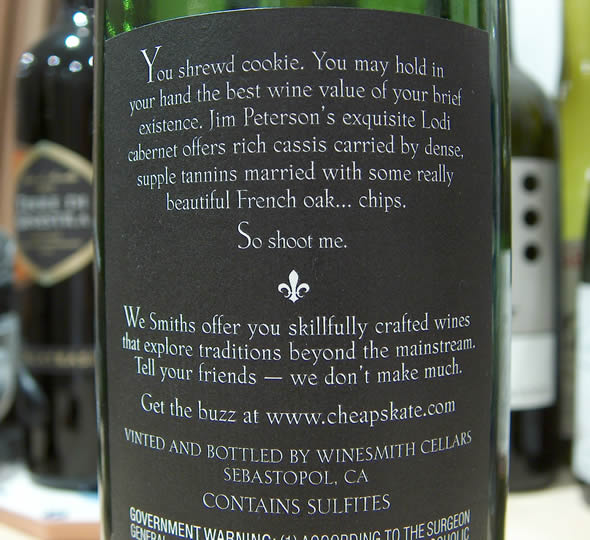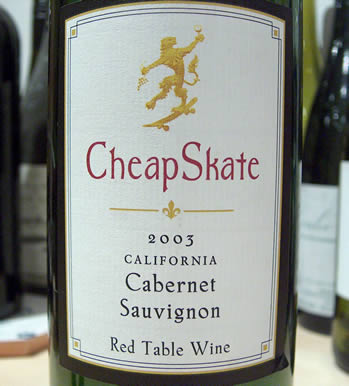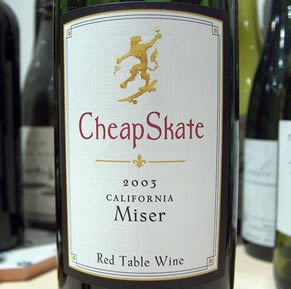|
Clark
Smith, Cheapskate and WineSmith: the application of technology in
winemaking

Clark Smith is a winemaker whose company, Vinovation,
offers hi-tech manipulations to wine growers in California.
Thatís a pretty prejudicial way of putting it, isnít it?
Itís makes him sound like an evil dude who fakes wine. Indeed,
it would be easy for journalists who might see themselves as
guardians of tradition authenticity to line up Smith in their
firing line and blast away: to those who think that naturalness is
important in wine, heís the enemy.
[See also my Clark
Smith interview: the surprising juxtaposition of technology and
natural wines.]
The truth, however, is more complex. Letís look at
the manipulation which Vinovation is best known for: reverse
osmosis. In Bordeaux this has attracted notoriety as a technique
by which must is concentrated before fermentation (the cross-flow
membrane takes water out). Originally, the idea was that if it
rained at harvest time, you could simply remove the excess water
that otherwise would have diluted your wine. Inevitably, some
producers went a bit further, recognizing that if concentration
was a quality valued by influential critics, here was a means for
achieving it in the winery. The result? Soupy, intense wines you
could stand a spoon in (or so those opposed to the technology
said).
However, in California, reverse osmosis is put to quite a
different use. There, thereís little worrying about harvest
rain. Instead, the vintage-time sunshine and warm temperatures
means that sugar levels rise rapidly as picking approaches,
leading to wines that are overly alcoholic, to the extent that
quality suffers. Smithís Vinovation have made good business
whacking some of the finished wine through reverse osmosis, taking
out alcohol and water. The alcohol is then distilled off this
separated portion, with the water being blended back into the
wine, resulting in a low alcohol batch of wine that can be
selectively blended back to the remaining original wine to produce
a final product with the desired alcohol level. This level is
determined by Ďsweet spotí tasting where a range of wines at
small increments in alcohol level are tasted blind. Apparently,
even small differences can make quite a big difference.
 It
sounds terribly manipulative, but is it any more manipulative than
chaptalization, the adding of sugar to must to raise the alcohol
level in the final wine? Chaptalís trick is widely practiced in
northern European wine regions, sometimes routinely, and as an
additive technique is perhaps even more naughty than one that
takes stuff out. Reverse osmosis is legal, too, unlike that other
classic alcohol-lowering technique of leaving a hosepipe running
into the must before fermentation. The big question is, how is the
treated portion of the wine altered by being whacked through a
cross-flow filtration device at high pressure? In an ideal world
winemakers would have terroirs which yield the right sort of
flavour maturity at sensible alcohol levels. But if you arenít
blessed with such a vineyard site, do you simply have to lump the
fact that your wines are being spoiled by being excessively
alcoholic? It
sounds terribly manipulative, but is it any more manipulative than
chaptalization, the adding of sugar to must to raise the alcohol
level in the final wine? Chaptalís trick is widely practiced in
northern European wine regions, sometimes routinely, and as an
additive technique is perhaps even more naughty than one that
takes stuff out. Reverse osmosis is legal, too, unlike that other
classic alcohol-lowering technique of leaving a hosepipe running
into the must before fermentation. The big question is, how is the
treated portion of the wine altered by being whacked through a
cross-flow filtration device at high pressure? In an ideal world
winemakers would have terroirs which yield the right sort of
flavour maturity at sensible alcohol levels. But if you arenít
blessed with such a vineyard site, do you simply have to lump the
fact that your wines are being spoiled by being excessively
alcoholic?
Another of Vinovationís techniques is
microoxygenation. Itís not uniquely theirs, but they do provide
this widely as a service. This involves the careful addition of
very small quantities of oxygen to wines at critical times in
their development. Thereís some controversy surrounding it,
merely because it is a bit of a suck it and see technique, relying
on experience and regular tasting of the treated wine to decide
how much is enough. Advocates suggest itís a brilliant way of
mastering elevage (the bringing up of a wine), helping to fix
colour and build structure. If itís done carelessly it hardens
the wines and dries them out; done well, it can make them more
complex and harmonious.
Of late, Clark Smith has been making small quantities of his own wines
under the Cheapskate (budget) and WineSmith (boutique) labels. The
Cheapskate 2003 Cabernet Sauvignon, an $8 bottle of wine, caused a
bit of a stir by winning Gold medal in the over $50 category of an
international wine competition (Jerry
D. Mead's New World International Wine Competition). [As an aside,
Smith is a very funny guy - look at the back labels, and the
wonderful logo on the front of a skateboarding animal, which takes
the p*** out of the way that so many Californian wines take
themselves very seriously indeed.] I tried this wine along with
some of his other offerings, and I was hugely impressed. Smith
knows what he is doing. The world needs affordable wine, and if he
can put out wines like his Cheapskate range for under US$10,
thatís good news indeed.
Cheapskate Cabernet Sauvignon 2003 California
Very dark coloured. A lovely enticing nose of ripe, full black
fruits with a subtle herby edge and some chocolatey richness:
itís perfectly in balance, fresh as well as ripe. The palate
shows a lovely, lush, silky mouthfeel with lots of concentration
and substance, but no hard edges. The sweetness of the fruit is
well complemented by the smooth but grippy tannins. Balance is the
key here: rich and full but not at all overblown. Utterly
delicious. Very good/excellent 90/100
 Cheapskate
Miser 2003 California Cheapskate
Miser 2003 California
A blend of Cabernets Sauvignon and Franc, this is an
attractive deep red colour. Thereís a minty, earthy edge to the
predominantly red fruits nose: quite delicate like a very ripe
claret. The palate is supple with smooth tannic structure
underlying the ripe yet restrained red fruits. A well balanced
wine thatís a bit European in style. Very good+ 88/100
Winesmith ĎFaux Chablisí 2002 Napa Valley
From the student vineyard at the Napa Valley College, this is
12.9% alcohol. Thereís a ripe, nutty, butterscotchy warmth to
the nose which is fresh and shows some floral notes. Itís quite
minerally. The palate shows good concentration with nutty flavours
and searing high acidity. Itís extremely dry with a sharp
finish. With its lean character, itís not at all what youíd
expect from Napa. But while itís nice to drink, itís not
totally convincing as a Chablis impersonator. Very good+ 89/100
(this retails for around $30)
Winesmith Crucible 1999
Complex, spicy and slightly evolved with tarry notes and some
fruit sweetness. The palate is smooth and spicy, with some
structure and a bit of evolution. Thereís a hint of earthiness.
It is quite drying; more savoury than opulent. Red fruits
dominate, but there is some dark fruit too. Some elegance:
everything is pulling together, and itís drinking very well, and
more supple than the conventional Crucible (see below). The next
day, itís a better wine than the conventionally vinified
version, showing very well. Very good/excellent 91/100 (this is a
bit more pricey, at about $65)
Winesmith Crucible 1999 (Conventional vinification)
Slightly darker coloured. Tight, slightly meaty, liquoricey
red and black fruits nose. Thereís a meaty, chocolatey edge to
the palate which is more primary, and has tight tannins. Both
wines are quite different structurally. This version is brawnier
and bolder, structured and tannic Ė certainly tasty in its own
style, but less refined and not really ready. The next day this is
showing signs of oxidation compared with its peer. Very
good/excellent 90/100
www.cheapskate.com

See also: a more recent
interview with Clark, tasting through a selection of his wines
Wines tasted 08/05
Find
these wines with wine-searcher.com
Back
to top
|

